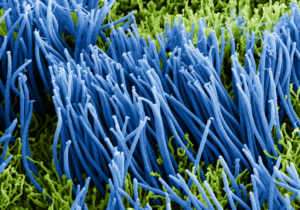Get the latest
Get MatTek offers and updates delivered to your inbox.

Within the body, the lung serves the critical function of exchanging carbon dioxide with the environment, taking in oxygen as a powerful electron transporter for aerobic respiration. From a modeling perspective, the lung is an extremely complex tissue to mimic as it serves such a critical function while having a highly plastic and complex architecture that is in direct contact with the external environment. Because of this complexity, many researchers have relied heavily upon animal models to mimic the lung and to execute drug discovery and development efforts as well as basic and translational research.
EpiAirway is a ready-to-use, 3D mucociliary tissue model consisting of normal, human-derived tracheal and bronchial epithelial cells also available as a co-culture system with normal human stromal fibroblasts (EpiAirwayFT). Cultured at the air-liquid interface (ALI), EpiAirway recapitulates the in vivo phenotypes of barrier, mucociliary responses, infection, toxicity responses and disease. With over 100 technical references available, EpiAirway is amenable to acute or long-term chronic studies across a wide range of highly predictive in vitro applications.
EpiAirway exhibits human relevant tissue structure and cellular morphology with high uniformity and reproducibility. Its 3D structure consists of organized Keratin 5+ basal cells, mucus producing goblet cells, functional tight junctions and beating cilia. EpiAirwayFT incorporates human fibroblasts in an extracellular stromal matrix ideal for inflammation and fibrosis research.

EpiAlveolar is a 3D co-culture model of the air-blood barrier. Produced from primary human alveolar epithelial cells, pulmonary endothelial cells and fibroblasts, EpiAlveolar is an in vitro model system developed to mimic human-relevant biological responses. The model is commonly used by researchers to study the following:

MatTek is very flexible in providing custom models for its customers. The EpiAirway model has 30+ donors available which include asthma, COPD and smoker profiles to address various research questions.
Get MatTek offers and updates delivered to your inbox.